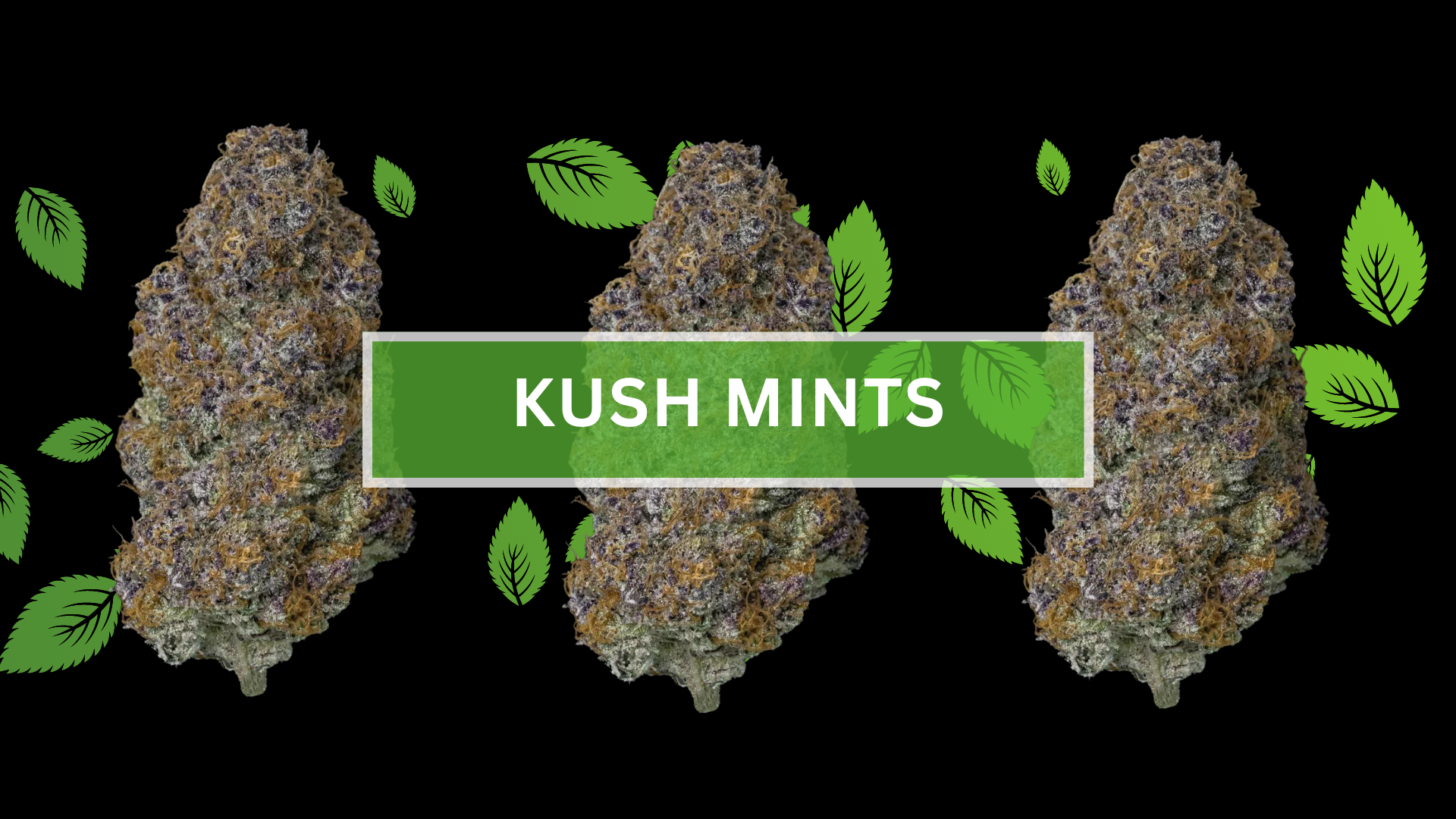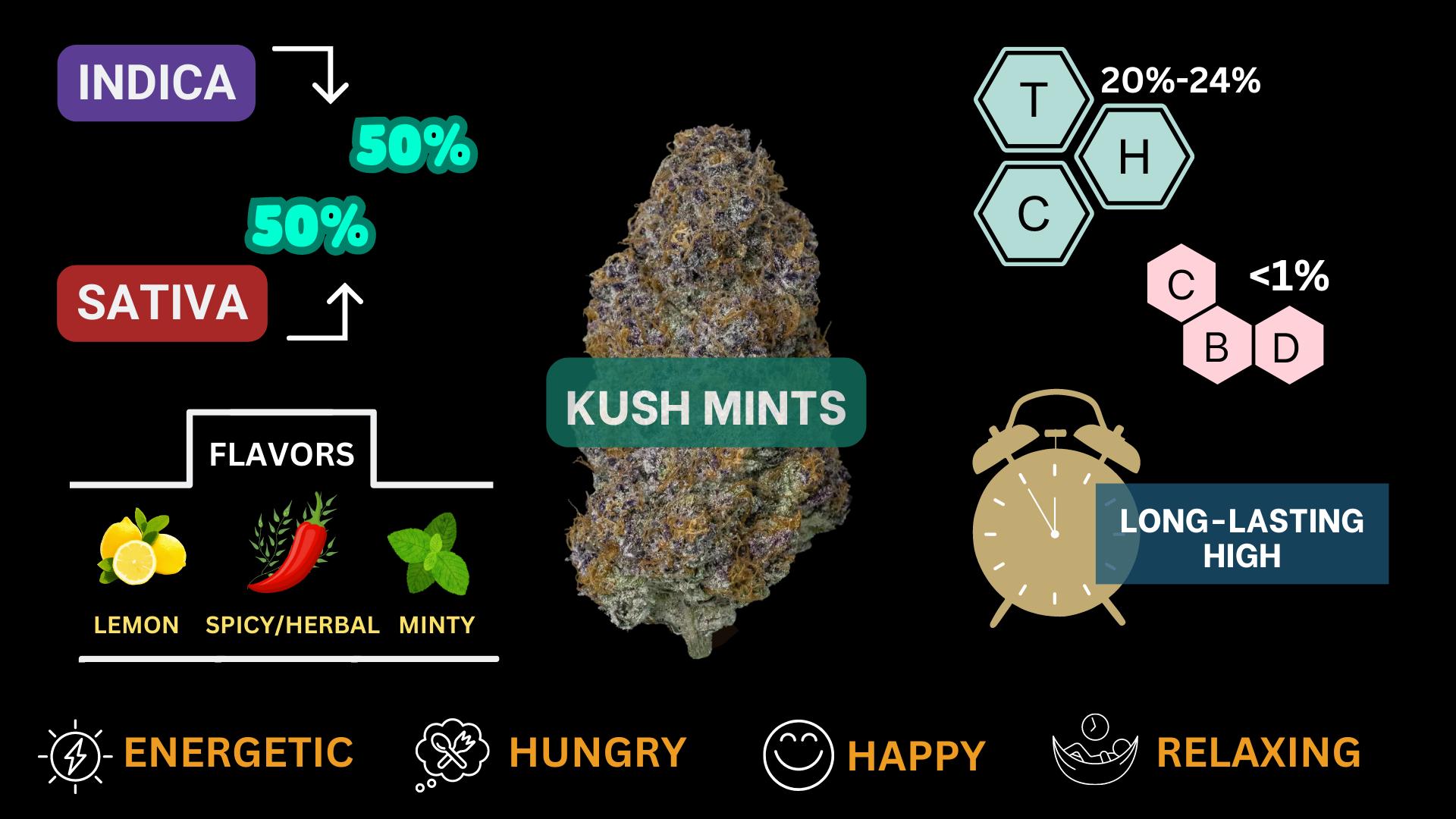KUSH MINTS STRAIN: THE ICONIC MINTY HYBRID CULTIVAR
Kush Mints has built a reputation as one of the most recognizable hybrids on dispensary menus today. Known for its dense trichome-coated buds, signature minty aroma, and versatile genetic makeup, this cultivar has become a favorite among cannabis breeders and seasoned consumers alike. But there’s much more to Kush Mints than its frosty appearance and fresh scent.
In this deep dive, we’ll explore the strain’s origin, terpene profile, cultivation history, and lesser-known insights that give Kush Mints its legendary status.

Where Did Kush Mints Come From?
Kush Mints is the creation of Seed Junky Genetics, a well-respected breeder known for cultivating heavy-hitting, exotic strains. Bred from Animal Mints x Bubba Kush, this 50/50 hybrid pulls from iconic West Coast genetics and leans into traits that growers and extract artists prize.
Parent Lineage Breakdown
Animal Mints brings a blend of Girl Scout Cookies and SinMint Cookies genetics. This parent strain is known for its thick resin, vibrant color contrasts, and fresh minty notes layered with herbal complexity.
Bubba Kush is a classic Indica-dominant strain with an unknown lineage, though it's commonly believed to stem from an Afghani and OG Kush cross. Its influence in Kush Mints can be seen in the stocky bud structure and rich, earthy backbone in both flavor and aroma.

Appearance and Structure
Kush Mints buds are often dense, conical, and generously frosted with milky-white trichomes. Beneath the layer of resin, expect forest green hues with streaks of deep violet and contrasting orange pistils. The compact structure, reminiscent of its Kush lineage, makes it an attractive option for flower and concentrate formats alike.
Terpene Profile: The Aroma Behind the Mint
Kush Mints is known for its fresh, minty nose with complex layers of spice and citrus. This aromatic diversity is thanks to its dominant terpenes, particularly:
Limonene – Often associated with citrus peels, this terpene gives Kush Mints its lemon-forward edge.
Caryophyllene – Found in black pepper and cloves, this terpene adds a spicy warmth to the profile.
Linalool – A floral terpene found in lavender and basil that softens the aroma with herbal undertones.
Other notable contributors may include pinene and myrcene, depending on the phenotype and growing conditions, which can influence the strain’s piney or slightly earthy notes.

Cultivation Tips for Growing Kush Mints
While Kush Mints is a photogenic and rewarding cultivar, it can be moderately challenging for novice growers due to its need for careful climate control and airflow.
Indoor & Outdoor Growing Considerations
Preferred climate: Mediterranean-like environments with moderate humidity.
Training methods: Topping and low-stress training (LST) help increase yield and encourage light penetration.
Soil & nutrients: This strain thrives in well-aerated, nutrient-rich soil. Be mindful of nitrogen levels during early veg and calcium-magnesium support during bloom.
Airflow: Dense buds require good air circulation to prevent mold or mildew development.
Harvest & Curing Tips for Optimal Terpene Retention
Kush Mints is typically ready for harvest around 8–9 weeks indoors. Look for milky-white trichomes with some ambering for peak cannabinoid development.
Drying: Hang whole plants or large branches in a dark, humidity-controlled environment (ideally 60°F and 60% RH).
Curing: After drying, cure in glass jars for at least 3–4 weeks. This helps preserve and express the strain’s signature minty aroma.
Notable Crosses and Phenotypes
Kush Mints has become a staple in breeding programs, spawning numerous fan-favorite crosses:
Jealousy (Kush Mints x Gelato 41): A top-seller in both California and other adult-use markets.
The Soap (Kush Mints x Animal Mints): A complex, aromatic cultivar with vibrant terpene expressions.
Kush Cake (Wedding Cake x Kush Mints): A hybrid known for its dessert-like aroma and deep coloration.
Due to its popularity, clone-only phenos of Kush Mints have become hot commodities among growers and extractors. Expect high trichome output and dense colas from these select cuts.

Kush Mints in the Cannabis Community
From Reddit threads to budtender recommendations, Kush Mints has garnered a loyal following. It frequently appears on “top 10 strains” lists and continues to influence terpene-focused breeding projects.
Its minty scent and versatile lineage have made it especially popular in:
Live rosin and hash production due to its trichome-rich flowers.
Vape cartridges, where its mint-forward nose can still be detected in high-terpene extract forms.
Strain-specific edibles, where its name alone drives curiosity.
Lesser-Known Facts About Kush Mints
Clone popularity: Certain cuts of Kush Mints (especially from Seed Junky) are exclusive and command premium prices.
Resin output: Kush Mints is highly sought after by concentrate makers for its high-yielding resin glands.
Mint terpenes: The “mint” flavor isn’t from menthol itself but from the combination of limonene, pinene, and linalool, which together create a cooling, refreshing aroma.
Kush Mints Pairing Inspiration: Culinary Crossover
Kush Mints’ complex flavor lends itself well to infused recipes that highlight its herbal and citrus characteristics. One creative example is a Herb Bruschetta recipe that mirrors the strain’s terpene profile.
Key herbs like basil, mint, and lemon zest echo the plant’s aromatic palette, while an optional infusion using cannabis olive oil pays homage to its roots.
Note: Always clearly label cannabis-infused products and consume responsibly, especially when preparing edibles at home.
Kush Mints Pairing Inspiration: Culinary Crossover
Kush Mints’ complex flavor lends itself well to infused recipes that highlight its herbal and citrus characteristics. One creative example is a Herb Bruschetta recipe that mirrors the strain’s terpene profile.
Key herbs like basil, mint, and lemon zest echo the plant’s aromatic palette, while an optional infusion using cannabis olive oil pays homage to its roots.
Note: Always clearly label cannabis-infused products and consume responsibly, especially when preparing edibles at home.
FAQs
While not as rare as some boutique strains, select phenotypes and clone-only cuts can be harder to find.
Yes, but it performs best in dry, temperate climates with ample airflow.
Some breeders offer Kush Mints seeds, but many growers prefer clone-only cuts for consistent quality.
STIIIZY complies with all applicable state laws regarding the sale and marketing of cannabis products. This content is intended for adults 21+ in jurisdictions where cannabis use is legal under state law. By engaging with this material, you acknowledge that you are of legal age in your jurisdiction.
This content is for informational and educational purposes only. It is not intended to diagnose, treat, cure, or prevent any disease or medical condition. STIIIZY makes no health claims about cannabis products. Consult a licensed healthcare professional before using cannabis, especially if you are pregnant, nursing, or have a medical condition.
Cannabis products may affect individuals differently. Consume responsibly and avoid operating vehicles or machinery after use. STIIIZY disclaims all liability for any adverse effects, legal consequences, or misuse resulting from the use of our products or reliance on this content.
Cannabis laws vary by state and locality. This content does not constitute legal advice. Users are responsible for understanding and complying with their local regulations.
Statements about product effects or benefits are based on general industry knowledge and user experiences. Individual results may vary. STIIIZY does not guarantee specific outcomes.
References to third-party studies, testimonials, or external resources are provided for context only. STIIIZY does not endorse or validate these materials unless explicitly stated.
The views and opinions expressed in this blog are those of the author and do not necessarily reflect the official policy or position of STIIIZY.

